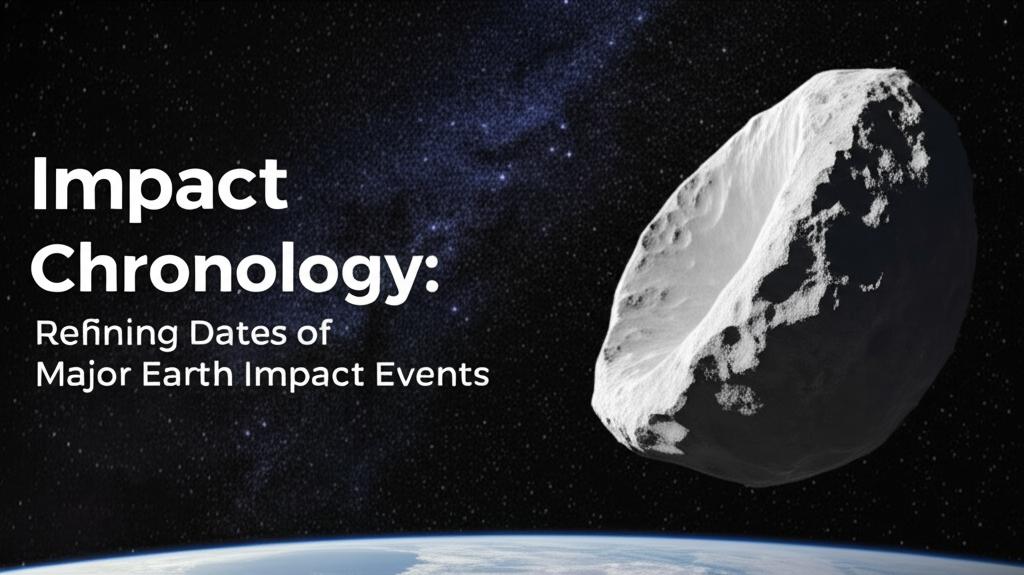Accurately dating major Earth impact events is crucial for understanding our planet's geological and biological evolution. Precise dating allows scientists to correlate impacts with significant events like mass extinctions and to reconstruct the impact flux in the inner Solar System.
Advancements in Dating Techniques
Recent years have seen significant progress in refining the ages of terrestrial impact structures. This is largely due to advancements in geochronological methods, particularly:
- U-Pb (Uranium-Lead) dating of accessory minerals like zircon: Zircon (ZrSiO4) has proven invaluable in dating impact events. Shock-induced microstructures within zircon crystals, such as planar deformation features or granular textures, can preserve evidence of the impact. Coupled with advanced analytical techniques like high-resolution Secondary Ion Mass Spectrometry (SIMS) and Chemical Abrasion-Isotope Dilution Thermal Ionization Mass Spectrometry (CA-ID-TIMS), U-Pb dating of shocked zircons provides highly precise and accurate ages for impact events. This is because these methods can effectively "reset" the isotopic clock at the time of impact or date newly formed minerals during the impact process.
- Ar-Ar (Argon-Argon) dating: This technique is also widely used and has provided precise ages for many impact events, including the Chicxulub impact, which is linked to the Cretaceous-Paleogene (K-Pg) mass extinction. High-precision Ar-Ar dating of materials like tektites (glassy ejecta) and impact melt rocks can yield ages with very small uncertainties.
- Radiocarbon (14C) dating: For very recent, smaller impact events, 14C dating of organic material found within or beneath ejecta layers is the primary method. Challenges exist, such as ensuring the dated material was directly killed by the impact to avoid discrepancies caused by the "old wood problem" (where older, preserved organic material is incorporated into ejecta). Researchers are refining sampling strategies, such as dating organisms killed directly by the impact or analyzing multiple samples from different locations within a strewn field to improve accuracy.
Crater Counting and Surface Dating
While radiometric dating provides absolute ages, crater counting is a relative dating method used extensively for planetary surfaces, including the Moon and Mars. This method assumes that a newly formed surface has no impact craters and that craters accumulate at a known rate.
- Calibration: Crater counting has been calibrated using radiometric ages from lunar samples returned by the Apollo and Luna missions.
- Refinements: Recent advancements include the use of high-resolution imagery from orbiters like the Lunar Reconnaissance Orbiter (LRO) to create more detailed crater catalogs. This allows for more accurate crater size-frequency distributions (CSFDs). Updated lunar chronology functions, incorporating new data points like those from the Chang'e-5 mission, help refine Martian surface dating models as well.
- Distinguishing Primary and Secondary Craters: A key challenge is distinguishing primary impact craters (formed by the initial impactor) from secondary craters (formed by ejecta from a primary impact). Researchers are developing improved methods, including machine learning and GIS-based clustering, to identify secondary craters more accurately, which can help refine surface age estimates and even use secondaries as stratigraphic markers.
Significance of Precise Impact Chronology
Refining the dates of major Earth impact events has several important implications:
- Understanding Earth's History: Precise dates allow for the correlation of impacts with major geological and biological events, such as mass extinctions, climate change, and the evolution of life. For instance, the Chicxulub impact's age has been pinpointed with high precision, strengthening its link to the demise of the dinosaurs.
- Assessing Impact Flux: A more accurate timeline of impacts helps quantify the rate at which asteroids and comets have struck Earth and other bodies in the inner Solar System throughout geological time. This data informs models of Solar System evolution.
- Identifying Synchronous Events: Precise dating helps determine if multiple impact events occurred simultaneously or in close succession, which could have compounded environmental effects. Currently, evidence for large-scale multiple impact events on Earth is limited.
- Studying Early Earth and Habitability: Constraining the timing of impacts on early Earth provides insights into the conditions that may have affected the origin and evolution of life. Impact craters can also create hydrothermal systems, which may have served as habitats for early microbial life.
- Lunar and Planetary Science: Studying Earth's impact record, alongside that of the Moon, provides a more complete picture of the bombardment history of the Earth-Moon system. This is crucial as Earth's active geology erases craters over time, while the Moon preserves a more ancient record. Recent studies comparing lunar and terrestrial crater records suggest that the impact rate on both bodies may have increased around 290 million years ago.
Ongoing Research and Future Directions
The field of impact chronology is constantly evolving. Ongoing efforts focus on:
- Discovering and Dating More Craters: Many impact structures on Earth likely remain undiscovered or unconfirmed. Continued geological mapping and the application of advanced dating techniques to suspected impact sites are essential.
- Improving Analytical Precision: Scientists continually work to reduce uncertainties in radiometric dating methods.
- Integrating Multiple Dating Methods: Combining data from different geochronometers and techniques provides more robust age constraints.
- Understanding Shock Metamorphism: Further research into how different minerals respond to shock pressures and temperatures helps refine their use as impact event recorders.
- Investigating the Role of Impacts in Extinctions: While the Chicxulub impact is strongly linked to a mass extinction, the role of other impacts in biotic crises remains an active area of research.
By continually refining the impact chronology of Earth, scientists gain a clearer window into the dynamic processes that have shaped our planet and the life it harbors.

